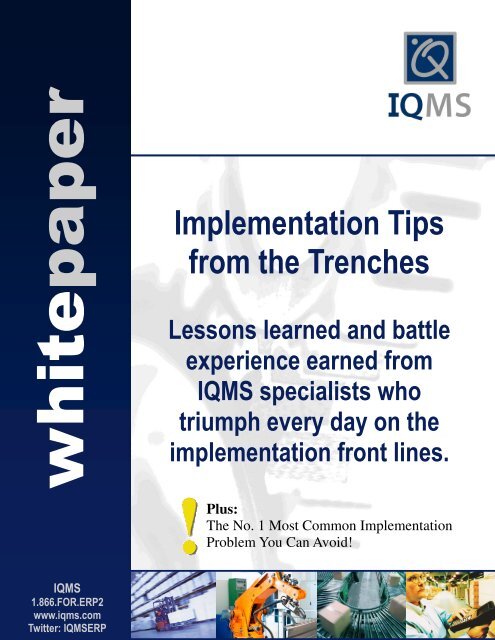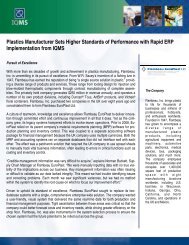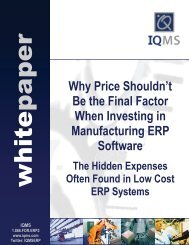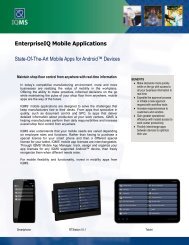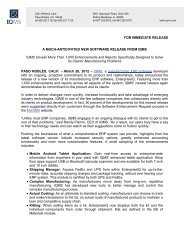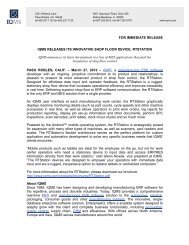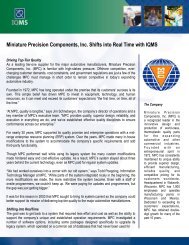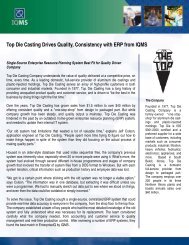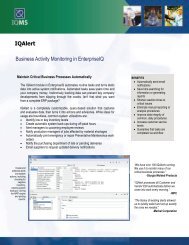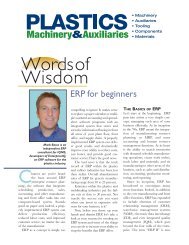ERP Implementation Tips from the Trenches - IQMS
ERP Implementation Tips from the Trenches - IQMS
ERP Implementation Tips from the Trenches - IQMS
Create successful ePaper yourself
Turn your PDF publications into a flip-book with our unique Google optimized e-Paper software.
whitepaper<br />
<strong>Implementation</strong> <strong>Tips</strong><br />
<strong>from</strong> <strong>the</strong> <strong>Trenches</strong><br />
Lessons learned and battle<br />
experience earned <strong>from</strong><br />
<strong>IQMS</strong> specialists who<br />
triumph every day on <strong>the</strong><br />
implementation front lines.<br />
Plus:<br />
The No. 1 Most Common <strong>Implementation</strong><br />
Problem You Can Avoid!<br />
<strong>IQMS</strong><br />
1.866.FOR.<strong>ERP</strong>2<br />
www.iqms.com<br />
Twitter: <strong>IQMS</strong><strong>ERP</strong>
Congratulations on <strong>the</strong> selection of your new <strong>ERP</strong> software solution! According to Panorama Consulting<br />
Services’ 2012 <strong>ERP</strong> Report, 54 percent of implementations take longer than anticipated and 56 percent<br />
cost more than budgeted. While <strong>the</strong>se budget and duration overrun numbers are not an accurate<br />
reflection of <strong>IQMS</strong>’ services, <strong>the</strong>y are still numbers that no one in <strong>the</strong> <strong>ERP</strong> industry can be proud of.<br />
The successful and timely implementation of a new <strong>ERP</strong> solution requires deep analysis of your unique<br />
business requirements and objectives. <strong>IQMS</strong> has experienced that outside, third-party resellers and<br />
implementers do not have <strong>the</strong> <strong>ERP</strong> customer’s best interests in mind. That is why we deploy dedicated<br />
implementation specialists who configure <strong>the</strong> EnterpriseIQ system to work intricately with your business,<br />
including recommending best-use practices so you can take full advantage of <strong>the</strong> software.<br />
Based on <strong>the</strong>ir hard-earned experience on <strong>the</strong> front lines, below are <strong>IQMS</strong>’ <strong>Implementation</strong> Specialists’<br />
suggestions for keeping your implementation process on<br />
track:<br />
Building Your Team<br />
Much like your Fantasy Football league, <strong>the</strong> members you<br />
draft for your team are essential to your success. From<br />
experience, <strong>IQMS</strong> recommends productive, mid-level<br />
“Your ideal team members are<br />
big picture thinkers who<br />
understand <strong>the</strong> overall<br />
business and <strong>the</strong> company’s<br />
end goals. ”<br />
employees for your starting lineup. We are not suggesting that top management support is anything but<br />
critical. It is simply that executive-level employees are busy and tend to make better members of <strong>the</strong><br />
steering committee. In place primarily to make <strong>the</strong> tough decisions <strong>the</strong> core team cannot, steering<br />
committee members are important, but do not need to be on <strong>the</strong> primary “go to” team.<br />
The ideal team members are big picture thinkers who understand <strong>the</strong> overall business and <strong>the</strong><br />
company’s end goals. They are power users who understand <strong>the</strong>ir department inside and out and are<br />
willing to see where <strong>the</strong>y can align <strong>the</strong>ir processes within <strong>the</strong> new system, ra<strong>the</strong>r than trying to implement<br />
over what is currently in place. Not every role in <strong>the</strong> company can be represented in <strong>the</strong> core team, so<br />
task-level employees will need to be pulled in when necessary, but <strong>the</strong>y do not need to be primary team<br />
members.<br />
<strong>Implementation</strong> <strong>Tips</strong> <strong>from</strong> <strong>the</strong> <strong>Trenches</strong><br />
www.iqms.com<br />
2
“A knowledgeable, enthusiastic, cross-functional team will be <strong>the</strong> foundation for your implementation’s<br />
success,” said Lee Filbert, <strong>IQMS</strong> Professional Services manager. “Look at your whole organization and<br />
provide an opportunity to personnel that show a passion for systems. You may find <strong>the</strong> right team<br />
members on <strong>the</strong> shop floor or in <strong>the</strong> office.”<br />
How many members should make up your team? That depends on <strong>the</strong> size of your organization. In a<br />
smaller outfit, one employee may wear many hats, so your team will naturally be smaller. Just be sure<br />
that every major area is represented, including <strong>the</strong> critical separate functionalities within each<br />
department. In more sizable organizations, <strong>IQMS</strong> cautions against assembling a team that is too large.<br />
Teams of more than 12 can slow down <strong>the</strong> decision making process as too many voices struggle to agree.<br />
In <strong>the</strong> end, when selecting your team, be sure to remember that an <strong>ERP</strong> implementation is not an IT<br />
project. IT plays a critical role, but it is an enterprise-wide business solution project and all <strong>the</strong> applicable<br />
areas should be represented.<br />
For companies with multiple facilities, particularly those spread out across <strong>the</strong> globe, selecting <strong>the</strong> right<br />
team members is even more critical. Multiple facility team make-up is determined by available resources<br />
and <strong>IQMS</strong> finds that multi-plant implementation teams usually manifest as one of <strong>the</strong>se two options:<br />
One Core <strong>Implementation</strong> Team:<br />
<strong>IQMS</strong>’ implementation specialists recommend a core of employees that are hand-picked to be<br />
part of <strong>the</strong> larger team, plus a few employees <strong>from</strong> each individual plant who come on board<br />
when it is time to bring <strong>the</strong>ir specific plant live. The core team travels <strong>from</strong> plant to plant and<br />
works to bring each new facility online, passing along <strong>the</strong>ir knowledge earned <strong>from</strong> previous<br />
plant implementations.<br />
“Typically when I do multi-plant implementations, I like to have two, three, maybe four people that<br />
are on all <strong>the</strong> teams,” said Jim Hoium, <strong>IQMS</strong> Application Specialist. “Those three or four core<br />
people travel <strong>from</strong> plant to plant when it is time to implement. The rest of <strong>the</strong> team is made up of<br />
individuals <strong>from</strong> each plant.”<br />
<strong>Implementation</strong> <strong>Tips</strong> <strong>from</strong> <strong>the</strong> <strong>Trenches</strong><br />
www.iqms.com<br />
3
Mirror <strong>Implementation</strong> Teams:<br />
Sometimes pulling employees completely <strong>from</strong> <strong>the</strong>ir jobs to travel <strong>from</strong> plant to plant is not a<br />
realistic option. In that case, <strong>IQMS</strong>’ implementation specialists recommend <strong>the</strong> mirror approach<br />
to best manage your resources. At your first plant, define <strong>the</strong> roles that are essential to <strong>the</strong> team<br />
(one <strong>from</strong> accounting, one <strong>from</strong> manufacturing, etc.), <strong>the</strong>n mirror those exact roles for <strong>the</strong> team<br />
at <strong>the</strong> next plant.<br />
“When you can’t pull people out of <strong>the</strong>ir existing jobs to travel <strong>from</strong> plant to plant, <strong>the</strong>n I<br />
recommend <strong>the</strong> mirror approach,” said Kristina Bianchi, <strong>IQMS</strong> Senior <strong>Implementation</strong> Specialist.<br />
“I have specific people in line for <strong>the</strong> first plant, so when I go to <strong>the</strong> next plant, I can pull those<br />
same types of roles.”<br />
Business Process Blueprinting:<br />
Well-defined business procedures are <strong>the</strong> basis for<br />
a successful implementation. In fact, nearly industry<br />
wide, <strong>ERP</strong> vendors will agree that business process<br />
“The ga<strong>the</strong>ring and development of<br />
flow charts, work instructions and<br />
o<strong>the</strong>r documents related to your<br />
work flow, also known as business<br />
process blueprinting, is a critical<br />
implementation success factor. ”<br />
blueprinting (<strong>the</strong> ga<strong>the</strong>ring and development of flow charts, work instructions and o<strong>the</strong>r documents<br />
related to your work flow) is a critical success factor of any implementation process.<br />
Some consider business process blueprinting like a marriage. You first need to understand yourself<br />
before you begin searching for a long-term partner. The spousal qualities you are looking for can be<br />
tweaked, but <strong>the</strong>re are certain attributes you absolutely must have. Most likely, your business process<br />
needs analyses are already in place for each department, as those blueprints were utilized in <strong>the</strong> <strong>ERP</strong><br />
vendor selection process when researching essential features and confirming whe<strong>the</strong>r <strong>the</strong> new software<br />
can solve your unique business requirements.<br />
To prepare for your new system, check that your process blueprints are generic and not tied to <strong>the</strong><br />
legacy system. For example, instructions such as printing ASNs should not include details specific to <strong>the</strong><br />
limitations of your legacy system. They should simply state, “Must send ASN.” Ideally, <strong>IQMS</strong><br />
<strong>Implementation</strong> <strong>Tips</strong> <strong>from</strong> <strong>the</strong> <strong>Trenches</strong><br />
www.iqms.com<br />
4
ecommends that you understand how your business operates first, define it during <strong>the</strong> <strong>ERP</strong> selection<br />
and <strong>the</strong>n refine it in implementation.<br />
<strong>Implementation</strong> Method: Phased or Big Bang?<br />
Finally, <strong>the</strong> complex and exciting new <strong>ERP</strong> software system you invested in has arrived on your<br />
doorstep. But where to start? Do you implement <strong>the</strong> entire package at once (commonly referred to as <strong>the</strong><br />
Big Bang method) or do you roll out <strong>the</strong> singular modules one at a time (also known as <strong>the</strong> Phased<br />
method)? Nei<strong>the</strong>r method is perfect and both contain <strong>the</strong>ir own set of challenges:<br />
Big Bang Concerns:<br />
Bringing up all <strong>the</strong> new modules at once and making a clean break <strong>from</strong> your legacy system<br />
seems very enticing. But Business-Software.com said it best in its Top 20 <strong>ERP</strong> Software<br />
Vendors Revealed report when <strong>the</strong>y discussed a common problem with <strong>the</strong> Big Bang approach:<br />
“‘Big Bang’ <strong>ERP</strong> implementations come with quite a bit of risk. Few businesses have <strong>the</strong><br />
resources to handle an all-at-once deployment. Therefore, it is critical to choose an <strong>ERP</strong> vendor<br />
with a flexible and modular platform, so it can be rolled-out in phases.”<br />
Phased Concerns:<br />
Some companies allow you to bring up one singular module (such as order entry) at a time. The<br />
greatest disadvantage to this method is it fosters resistance to change and requires dual efforts<br />
throughout your organization. If all you bring online is inventory control, <strong>the</strong>n everyone else down<br />
<strong>the</strong> pipeline (such as your scheduler and shipping department) is doing redundant data entry<br />
with <strong>the</strong> legacy system until <strong>the</strong>ir portion is brought online as well.<br />
<strong>IQMS</strong>’ comprehensive system model is unique, so we recommend a hybrid method of <strong>the</strong> two<br />
approaches above. <strong>IQMS</strong> encourages you to bring up <strong>the</strong> entire core (sales orders, scheduling,<br />
accounting, shipping, inventory, purchasing, etc.) at once because those tools are completely integrated<br />
and function at a premium when done in tandem. In addition to <strong>the</strong> core, <strong>IQMS</strong> recommends that you<br />
select some critical peripherals to bring online in Phase 1, based on individual company needs. Our<br />
<strong>Implementation</strong> <strong>Tips</strong> <strong>from</strong> <strong>the</strong> <strong>Trenches</strong><br />
www.iqms.com<br />
5
RealTime monitoring system is usually at <strong>the</strong> top of <strong>the</strong> list, followed by modules such as quality and<br />
warehouse management as we move down <strong>the</strong> phases. The key is to prioritize.<br />
Setting a Realistic Timeline<br />
Regardless of <strong>the</strong> implementation method you select, be careful you don’t bite off more than you can<br />
chew. All parties involved need to be realistic about <strong>the</strong> timeline. In <strong>the</strong> end, setting reasonable<br />
expectations boils down to available resources. If you can be practical about <strong>the</strong> number of employees<br />
and <strong>the</strong> percentage of <strong>the</strong>ir time you can assign to this project, <strong>the</strong>n your implementation specialist can<br />
offer an accurate idea of how long it should take.<br />
“<strong>Implementation</strong>s have a huge impact on your time,” said Hoium. “Most of <strong>the</strong> people picked for <strong>the</strong> team<br />
are already busy doing a full time job currently and we are asking <strong>the</strong>m to do ano<strong>the</strong>r full time job on top<br />
of that. I try to help people realize how much time <strong>the</strong>y have to offer and <strong>the</strong>n schedule <strong>the</strong> project<br />
accordingly.”<br />
If it helps, you can begin by breaking <strong>the</strong> implementation process down into key milestones:<br />
Hardware Requirements:<br />
Take a good look at your hardware needs (and we don’t just mean servers). Do you have<br />
scanners? Do you have label printers? Are you installing RealTime? Are you using tablets or any<br />
o<strong>the</strong>r mobile devices on <strong>the</strong> shop floor? Do you have wireless access in <strong>the</strong> building? Hardware<br />
requirements are an often overlooked, yet a significant milestone to consider when planning your<br />
timeline.<br />
Data Migration:<br />
The old adage, “garbage in, garbage out,” has never been more accurate than when it comes to<br />
data migration. Carefully consider your data collection and input process (including sales orders,<br />
inventory items, BOMs, customers, vendors, etc.), <strong>the</strong>n begin deciding whe<strong>the</strong>r you plan to<br />
cleanse and start fresh <strong>from</strong> scratch, input every bit of data you own or scrub your current data<br />
and only enter what you need? Will you manually input your data or data load? If you are<br />
<strong>Implementation</strong> <strong>Tips</strong> <strong>from</strong> <strong>the</strong> <strong>Trenches</strong><br />
www.iqms.com<br />
6
manually entering data, be realistic about <strong>the</strong> amount of time your employees will be able to<br />
devote. Are <strong>the</strong>y 100 percent dedicated or 10 percent dedicated? Do <strong>the</strong>y have o<strong>the</strong>r responsibilities?<br />
“I am always amazed at people’s expectations. Is it realistic to expect to go live when you have<br />
10,000 bills of materials with only one person entering <strong>the</strong>m, giving 10 percent of his time? No.<br />
You have to be realistic about how long it is going to take and whe<strong>the</strong>r that meets <strong>the</strong> guidelines<br />
of what you are trying to achieve by go live,” said Bianchi.<br />
You must also consider your data strategy in regards to historical data. What do you need to<br />
import in order to maintain an accurate history? What do you do with <strong>the</strong> old data that you are<br />
not planning to import?<br />
Process Analysis and Training:<br />
This phase of implementation is where work instructions and standard operating procedures<br />
begin to take shape. Toge<strong>the</strong>r with your implementation specialist, you will work to adapt <strong>the</strong><br />
system to solve your operational needs while beginning <strong>the</strong> training process.<br />
“Successful implementation<br />
timelines occur when people<br />
are realistic with <strong>the</strong> amount<br />
of resources <strong>the</strong>y can offer. ”<br />
“This is your opportunity to make changes. Just because<br />
you’ve done something one way for <strong>the</strong> last 20 years<br />
doesn’t mean it’s good or it’s right. It doesn’t mean it’s<br />
wrong, it just means we should evaluate,” said Hoium.<br />
“What sets you apart <strong>from</strong> your competition? Those are <strong>the</strong> things that we’ve got to protect.<br />
Everything else should be on <strong>the</strong> table to discuss.”<br />
It is essential that you begin to shift work responsibilities at this stage. If you are introducing new<br />
functionality, such as warehouse management, be sure that <strong>the</strong> employee embracing this new<br />
project can be relieved of his o<strong>the</strong>r duties in order to focus on <strong>the</strong> new product and sufficiently<br />
train his team members. How much time do you plan to allow your employees for training and is<br />
management on board to follow up with those employees to check in on milestones along <strong>the</strong><br />
way?<br />
<strong>Implementation</strong> <strong>Tips</strong> <strong>from</strong> <strong>the</strong> <strong>Trenches</strong><br />
www.iqms.com<br />
7
Gap Analysis and Conference Room Pilot:<br />
This milestone identifies and uncovers areas of improvement before go live. Your implementation<br />
specialist will walk each department through <strong>the</strong>ir required daily activities, making sure <strong>the</strong> final<br />
work instructions and processes can be mapped for future use. Do you understand how to do<br />
your essential daily responsibilities? What do you still need to be trained on? Are <strong>the</strong>re any<br />
unknown “gotchas” lingering out <strong>the</strong>re?<br />
At <strong>the</strong> end of <strong>the</strong> implementation process, <strong>IQMS</strong>’ goal is to have no surprises that come out of<br />
<strong>the</strong> system and complete work instructions in place. That way, when it is time to flip <strong>the</strong> switch<br />
and go live, you can reliably pull out your work instructions and be successful.<br />
Go Live:<br />
This is <strong>the</strong> exciting moment when you bring EnterpriseIQ live at your facility. Then it’s all about<br />
successful repetition for Phase 2 or a new facility, if applicable.<br />
Most Common <strong>Implementation</strong> Problem:<br />
It is time to reveal <strong>the</strong> most common implementation problem that plagues companies of every size, in<br />
every industry. No surprise, it is Time Management. Regardless of your type of organization, time<br />
management is always a trying issue that rears its ugly head in every aspect of implementation, <strong>from</strong><br />
data migration to training.<br />
“It’s very common for people to wait until <strong>the</strong> last minute. They realize, oh my goodness, I am going live<br />
and <strong>the</strong>n <strong>the</strong>re is a mad rush. The largest challenge is that you can’t batch learn with EnterpriseIQ,<br />
because that is not how your day to day works. You have to do your processes side by side with your old<br />
software so you can feel and know how EnterpriseIQ is reacting compared to <strong>the</strong> way your legacy<br />
system reacts,” said Bianchi.<br />
Sometimes time management reveals itself in <strong>the</strong> form of procrastination because employees are<br />
uncomfortable or afraid of <strong>the</strong> new system. Employee change management issues manifest into time<br />
management problems. When <strong>IQMS</strong>’ implementation specialists are not on-site, employees still need to<br />
<strong>Implementation</strong> <strong>Tips</strong> <strong>from</strong> <strong>the</strong> <strong>Trenches</strong><br />
www.iqms.com<br />
8
train, record <strong>the</strong>ir standard operating procedures, make sure work<br />
instructions are in place and not get lax.<br />
If you can manage it, <strong>IQMS</strong> recommends that you have one employee<br />
100 percent dedicated to <strong>the</strong> implementation 100 percent of <strong>the</strong> time.<br />
They are <strong>the</strong> on-site driver offering assistance where departments might<br />
be lagging and making sure everyone is sticking to <strong>the</strong> timeline and<br />
getting <strong>the</strong>ir tasks done. Without a dedicated resource, it is hard to keep<br />
things moving forward.<br />
Hopefully <strong>the</strong> information in this whitepaper has emboldened you to take<br />
charge and embrace your implementation process. Armed and ready with<br />
<strong>the</strong>se important tips, you have taken steps in <strong>the</strong> right direction to<br />
conduct a successful implementation. The implementation process is not<br />
easy, but <strong>the</strong> efforts taken today will pay off handsomely in <strong>the</strong> future.<br />
Good luck!<br />
About <strong>IQMS</strong><br />
Since 1989, <strong>IQMS</strong> has been designing and developing <strong>ERP</strong> software for<br />
<strong>the</strong> repetitive, process and discrete manufacturing industries. Today,<br />
<strong>IQMS</strong> provides a comprehensive real-time MES and manufacturing <strong>ERP</strong><br />
software solution to <strong>the</strong> automotive, medical, packing, consumer goods<br />
What You Can<br />
Do to Prepare<br />
Before Your<br />
<strong>Implementation</strong><br />
Process Begins:<br />
Blueprint your<br />
business processes<br />
if not already<br />
documented<br />
Begin ga<strong>the</strong>ring<br />
appropriate data:<br />
documentation,<br />
work instructions,<br />
plant layouts,<br />
diagrams, etc.<br />
Start thinking about<br />
who you want on<br />
your team and <strong>the</strong><br />
amount of time <strong>the</strong>y<br />
will be able to<br />
devote to <strong>the</strong><br />
implementation<br />
project<br />
Begin to consider a<br />
rough timeline<br />
and o<strong>the</strong>r manufacturing markets. The innovative, single-database enterprise software solution,<br />
EnterpriseIQ, offers a scalable system designed to adeptly grow with <strong>the</strong> client and complete business<br />
functionality, including accounting, quality control, supply chain, CRM and eBusiness. With offices across<br />
North America, Europe and Asia, <strong>IQMS</strong> serves manufacturers around <strong>the</strong> world.<br />
Trademark and Copyright Acknowledgement<br />
Copyright © <strong>IQMS</strong> 2012. <strong>IQMS</strong> is a registered trademark of <strong>IQMS</strong>. All o<strong>the</strong>r trademarks acknowledged.<br />
<strong>Implementation</strong> <strong>Tips</strong> <strong>from</strong> <strong>the</strong> <strong>Trenches</strong><br />
www.iqms.com<br />
9


